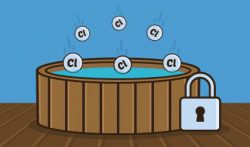Have you ever tested your swimming pool water and couldn’t get a chlorine reading? Figuring you must have done something wrong, you retest your water. Still no reading. So what do you do? Add chlorine, right? After days of adding chlorine and testing chemical levels, you still have no chlorine reading. At this point, your attitude turns from curious to annoyed.
Are your chemical levels imbalanced?
Are you using a reliable pool water test kit?
These are just two questions that need addressing before you can get to the real question, why does my pool have no chlorine?
Excluding chlorine, are the remaining chemicals in your pool balanced? Balancing your water is an important step that pool owners sometimes forget. The very first thing you want to do is get an accurate reading of your chemical levels.
If you don’t have a home testing kit, we recommend either purchasing one or taking a water sample to a local pool store and testing it there. Getting the most recent and the most accurate chemical readings is imperative before adding any additional chemicals.
If you test your pool water and can’t get a chlorine reading, it may be due to your pool’s high demand for chlorine. A high chlorine demand (sometimes referred as chlorine lock), simply means that although your water may appear clear and balanced, the chlorine in your pool is ineffective. But why?
 One of the causes of a high chlorine demand is an excessive buildup of algae and phosphates. Although you’re adding chlorine to your water, bacteria or algae are overpowering the chemicals causing it not to show up on tests strips or in water kits.
One of the causes of a high chlorine demand is an excessive buildup of algae and phosphates. Although you’re adding chlorine to your water, bacteria or algae are overpowering the chemicals causing it not to show up on tests strips or in water kits.
It’s like when you overdraft $200 from your bank account but only add $100 back. You’re still less $100 from the original overdraft. The chlorine in your pool acts the same way.
Keep in mind, organic materials like algae, leaves, sunscreen, lotions, pee, poop, and etc., consume chlorine. As chlorine does its job, it is depleted in the process. To prevent the demand for chlorine from happening, help remove the organic material from your pool water by brushing the algae from the pool walls, cleaning your filter, and removing leaves and debris from the water.
One of the ways phosphates get into your pool is through household cleaners. There are certain household cleaners that weren’t designed for the pool. Cleaner manufacturers add additional components to the composition such as phosphates or nitrates. The extra phosphates interfere with the pool’s current sanitizer and can cause a demand for chlorine.
Having too much cyanuric acid in your pool is another way to create a high demand for chlorine. Sometimes, it’s just a simple case of pool owners adding too much stabilizer to the water. Sometimes this occurs when you aren’t partially draining and refilling your pool periodically.
Adversely, very little or zero stabilizer also creates a demand for chlorine. Cyanuric acid, in a sense, acts like sunscreen for the pool. If you’ve ever worn sunscreen in the hot sun, you know that you have to consistently re-apply. Our pools are the same way. If your CYA levels are really low, the sun can burn through the chlorine in your pool rather quickly.
Other ways that can potentially cause a chlorine demand in your pool is excessive rain. When it rains, air pockets form in the raindrops and allows oxygen into the water. When this happens, your pool’s chemistry offsets, resulting in the demand for chlorine.
The quickest way to determine if your pool is experiencing a high demand for chlorine is to perform a test for free and total chlorine.
Free chlorine shows the level of disinfecting chlorine available to sanitize your pool. Free chlorine isn’t interacting with contaminants, yet. Total chlorine is the amount of chlorine, used or not, in your water.
We typically see more pools with a high demand for chlorine during spring opening season. A lot of the times, pools sit for months accumulating a ton of different contaminants. This is one of the reasons we always recommend balancing your pool before you close it. You don’t want to compile pool issues or push them to the side. Although high chlorine demand is more common than you might suspect, it is something pool owners can handle themselves.